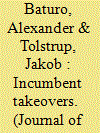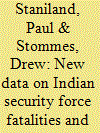|
|
|
Sort Order |
|
|
|
Items / Page
|
|
|
|
|
|
|
| Srl | Item |
| 1 |
ID:
160236


|
|
|
|
|
| Summary/Abstract |
Alliance politics are critical yet understudied in counterinsurgency interventions. Despite the importance of local allies, traditional research on alliances fails to account for the challenges of managing in-country counterinsurgency security partners or explain variation among which types of policy requests from large intervening allies are likely to result in compliance or defiance by local partners. When did US intervening forces have leverage in Iraq and Afghanistan, and when was American influence limited? Utilizing thousands of US government documents to analyze over 250 US demands of allies in Kabul and Baghdad, this paper reexamines established variables in the literature on inter-alliance bargaining—namely allied interests and dependencies—to offer a new model describing the interaction of these variables in asymmetric counterinsurgency partnerships. The theory predicts when large allies are likely to influence local partners and when these intervening forces will likely fail to coerce them.
|
|
|
|
|
|
|
|
|
|
|
|
|
|
|
|
| 2 |
ID:
190847


|
|
|
|
|
| Summary/Abstract |
The expansion of power by incumbent political leaders has become the subject of increased scholarly attention. In democracies, this is known as ‘subversions by the ruling executive’, ‘executive aggrandizement’, or ‘autogolpe’; in autocracies, researchers study ‘personalization’, ‘transition to personal rulership’, or ‘power-grabbing’. While the terminological landscape is rich, there is little conceptual agreement of what leader-driven power expansion is (and is not). Furthermore, we still lack broad data that allow us to investigate the phenomenon systematically across democracy and autocracy. The contribution of this article is twofold. First, it offers a unified approach to study leader-driven power expansion – incumbent takeovers – across the political regime spectrum. Second, drawing from 11 datasets and original data collection and coding, we introduce a new, comprehensive dataset on 495 individual takeover events carried out by 279 political leaders in 132 countries in the period 1918–2019. We provide estimates of the takeover onset years, the time to takeover, the length of the takeover spells, and discuss the differences between distinct indicators, inter alia. Future research may leverage these data for a better understanding of the drivers of incumbent takeovers as well as the role of takeovers in regime change, civil wars, coups, and uprisings.
|
|
|
|
|
|
|
|
|
|
|
|
|
|
|
|
| 3 |
ID:
167568


|
|
|
|
|
| Summary/Abstract |
National and state-level security forces across India operate against insurgents, criminals, and external threats. These operations are politically consequential, yet these forces tend to be quite opaque. This article provides new data on the fatalities that these forces have suffered in order to explore the location and nature of political violence in India. We create several new datasets of security force fatalities extracted from commemorative security force “martyrs” documents and online databases published by Indian state-level police organizations, the Ministry of Home Affairs (MHA), and the Ministry of Defence, as well as semi-official sources. The data vary wildly in quality and detail, and there are serious limits to their use. Nevertheless, they allow us to – with caveats – measure the location and incidence of violence, as well as the demographic underpinnings of the Indian Army, the two largest MHA paramilitaries, and several state police forces. Caveats aside, we anticipate that subsets of these data are sufficiently high in quality, facilitating future rigorous quantitative analysis on political violence in India. The entire dataset will be made publicly available.
|
|
|
|
|
|
|
|
|
|
|
|
|
|
|
|
|
|
|
|
|